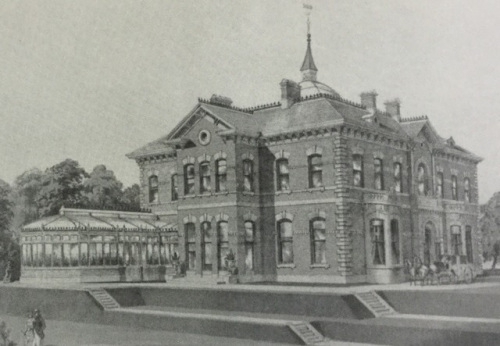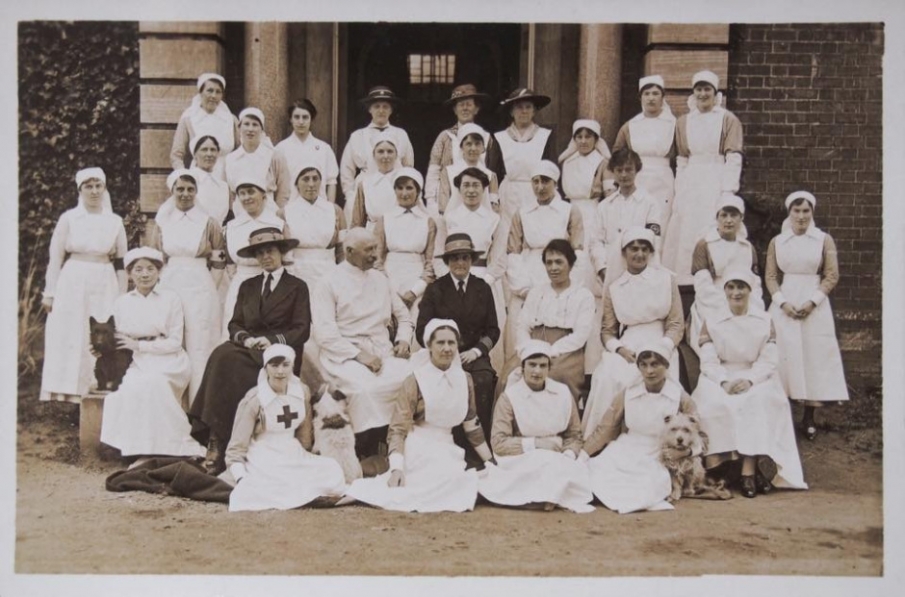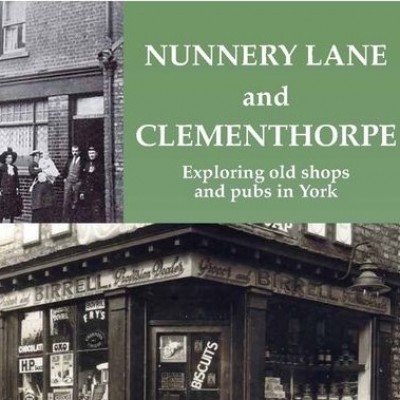Nunthorpe Hall: The Story of an Auxiliary Hospital in World War One
 Nunthorpe Hall – 19th Century engraving by P.Hyde
Nunthorpe Hall – 19th Century engraving by P.Hyde
One of the noteworthy buildings in our area during World War One was Nunthorpe Hall. This was in the area now built over as Coggan Close, between Albemarle Road and Philadelphia Terrace. The Hall was demolished in 1977.
During World War One the Hall was lent to the Red Cross by Sir Edward Lycett-Green, for use as a hospital. The house was described as being put into perfect order by Mr. and Mrs. Lycett-Green, who bore all expenses not covered by the government grant.
Pauline Alden and Anne Houson have been researching some of the women who worked there as nursing and medical staff at that time.
The hospital opened on 1 October 1915, with a convoy of men direct from the Battlefield of Loos. Initially there were 50 beds, organised into eight wards. The hospital’s capacity was later increased to 76 beds. When it closed on 14 April 1919, staff had treated 915 patients in total.
On the night of 2/3 May 1916 the hospital was bombed during a Zeppelin raid, two bombs setting fire to the house and four falling in the garden. There was considerable damage and the hospital had to be evacuated.
Mrs. Lycett-Green was the Commandant, and Miss Cudworth was the Quartermaster, succeeded by Mrs. Trail and later Mrs. Milner. Trained staff included one matron and three sisters, one sister could apply massage. Matron and two sisters lived in.
There were 24 VADs (Voluntary Aid Detachment nurses), including two cooks and two charwomen. The Medical Officers were Dr. Louise Fraser and Dr. Armytage.
As a result of their work, honours were conferred on the following
Mrs Lycett-Green, OBE, Lady of Grace of the Order of St John of Jerusalem
Miss Duggleby, Royal Red Cross medal (II) and mentioned in Orders. This was for exceptional devotion or competency in performance of nursing duties, an award exclusively for women.
Miss E Coates, Royal Red Cross medal (II) and mentioned in Orders
Miss Brown (cook) mentioned twice in Orders
Miss Cudworth, mentioned, and Hon Serving Sister of the Order of St John of Jerusalem
An inspection report of 22 January described the hospital as a good home, in excellent order with good food, with good staff accommodation.
George Henry Best from William St, a former pupil of Cherry St School, was a patient at Nunthorpe Hall in 1916/17. He spent ten months convalescing there and it must have been a great comfort to him and his family to be so close. He returned to the King’s Own Scottish Borderers, but sadly died as the result of wounds received at the Battle of Passchaendale in April 1918.

VADs and staff at Nunthorpe Hall Auxiliary Hospital 1918
Nunthorpe Hall VADs
Ruth Bengough started service at Nunthorpe Hall on 18 December 1916 at the age of 23. She worked 1,512 hours as a housemaid at Clifford Street Hospital during 1915-16, and was a nurse at Nunthorpe Hall, working a total of 7,695 hours. (Clifford Street VAD Hospital was in the Friends Meeting House building in Friargate, off Clifford St, behind the current building.)
Ruth was born in Durham, by 1911 she was living at Hawthorn Villa, Mount Villas, York. Her father was Cyril Francis Bengough, a civil engineer working for the railways. In 1904 he travelled to the USA as part of a group of North Eastern Railway (NER) senior officials, sent to study the American railways, and later became NER Chief Engineer. Ruth’s brother Lennard was a 2nd Lieutenant in the 6th Battery East Yorkshire Regiment serving in Gallipoli. He relinquished his commission on 20 July 1916 and moved to Vancouver in 1919. Ruth married Donald McKenzie in 1928, at the age of 35. Her husband served as a Private in the Royal Scots (Lothian Regiment) Reg. No.38413 and survived the War. Ruth died at the age of 77 in Cheltenham.
Dr. Sarah Louise Fraser was born in Inverness, her father was an iron founder manager, and she was educated at Bedford College, London. Sarah studied medicine at the London (Royal Free Hospital) School of Medicine for Women, qualified in 1901 and gained her MD in 1908. Dr. Fraser was living at 16, the Mount in 1911. Part of her early professional experience was gathered at the York Dispensary, providing a free domiciliary service for the poor of the city. In 1906 she opened her own practice, continued to work at the Dispensary and held a weekly clinic for women and children.
Dr. Fraser launched a public appeal for subscriptions and in 1908 the first Maternity Home in York opened in Ogleforth with five places. This increased and in 1923 it was handed over to the local authority. Dr. Fraser’s concern about the health of babies developed into an Infant Welfare Scheme and when the nutrition of mothers was improved, improvements to their infants ensued. Dr. Fraser was Medical Officer at Clifford Street Hospital from May-Dec. 1915, and Medical Officer at Nunthorpe Hall from 18 July until February 1918, when she became Medical Officer and Commandant. Throughout her service at Nunthorpe Hall Dr. Fraser was paid the sum of 3d. per bed!!
She was awarded an MBE in 1920. From 1926 she travelled a great deal and died in Bournemouth at the age of 84. Dr. Fraser’s obituary in the British Medical Journal of 29 November 1958 noted: “even at an advanced age, she still retained a keen interest in medical matters and in the profession that she had served so well”.
The Hodgson sisters, Emilie Rebecca, Hilda Ridgway, and (Mary) Gertrude Hodgson were VADs at Nunthorpe Hall. They were recorded as living ‘on private means’ at Park House, Park Street, York. Their father (deceased) was a retired farmer and their brother Norman was a stock and share broker. Their brother John was a driver in the Royal Artillery (80255) in France and Flanders. He was killed in action on 9 April 1917 aged 41.
Gertrude started service at Nunthorpe Hall on 1 Oct. 1915 at the age of 42. She worked as a nurse and housemaid for a total of 6,482 hours. Gertrude did not marry and died in 1932. Hilda also started service at Nunthorpe Hall on 1 October 1915 at the age of 26. She worked as a nurse and housemaid for 6,152 hours. Hilda married Dick Mawson at the age of 29 in 1919. Dick was a private in the East Yorkshire Regiment (No. 201714) and survived the War. Emilie started service at Nunthorpe Hall on 9 July 1916 at the age of 30, working as a cook and orderly, for a total of 4,688 hours. Emilie married Charles Thorp at the age of 35 in 1921.
Ella Dunnington–Jefferson carried out nursing and voluntary duties at Clifford Street and Nunthorpe Hospitals. She started service at Nunthorpe Hall in October 1915 at the age of 26. Ella worked a total of 2,000 hours before going on to become a munitions worker at T.E. Cooke’s in Bishophill. Her family were living at Thicket Priory, Thorganby, York.
Ella had two sisters, Hilda and Dorothy, who were also nursing overseas, working as VADs for the Queen Alexandra’s Imperial Nursing Service (QAIMNS). They disembarked for France and Flanders on 2 June 1915 at the ages of 28 and 33. They served with the British Red Cross Society and the Order of St. John. Hilda and Dorothy were awarded medals. Their brother, Second Lieutenant Wilfrid Dunnington-Jefferson, volunteered at the beginning of the war and served with the Royal Fusiliers. He was tragically killed in action at the Battle of Ypres on 25 April 1915 at the age of 23. He is commemorated on the Menin Gate and on the Memorial in St. Clement’s Church. Their brother Major John Dunnington-Jefferson served on the Headquarters Staff with the Expeditionary Force in France, and survived the War. The three sisters did not marry, choosing to live independent lives. Hilda Dunnington-Jefferson travelled a great deal and had many adventures including climbing the Matterhorn. She died at the age of 101 at St. Teresa’s Home, Roland Gardens, London SW7.
Mary Florence Lindberg started service at Nunthorpe Hall in 1915 aged 54, working as a nurse. She carried out six weeks duty at the Station Rest Van in 1915 and 90 hours at the Stranded Soldiers Club. Mary completed service at Nunthorpe Hall in 1916. She was living at Acomb House, Acomb in 1911, with her husband, Thomas Henry Lindberg, who was an artist living on private means. He had also served in previous conflicts and was described as a Reserve Officer (Land Forces). In 1914 Thomas Lindberg was a Major of the Northumberland Fusiliers (24461) and was on a Special List, Home Service only, New Armies. Tragically Major Lindberg died on 24 May 1915 at the age of 56 in Leeds. Mary’s son, Captain Oscar Henry Lindberg, served with the Northumberland Fusiliers at Gallipolli in May 1915 and later served in France. He survived the war.
Mary’s daughter Olga Florence Annie Lindberg was an authoress. Another daughter, Alice Mary Lindberg, was a VAD in QAIMNS and became a nurse working for the British Committee, French Red Cross and was awarded medals. She disembarked for France in April 1915 at the age of 30, becoming a member of QMAAC (Reg. No. 13490). Alice married Cuthbert Addison Fenwick at Great Ouseburn in Dec. 1917. Her husband served as a Lieutenant in the Royal Guernsey Artillery and departed for France in Apr. 1918.
Ethel Maud Shouksmith started service at Nunthorpe Hall on 1 October 1915 and worked full-time as a cook. Her family were Wesleyan Methodists and she was baptised at New Street Chapel. Emily’s father was J. H. Shouksmith of Shouksmith & Sons Ltd. The Company were plumbers and ironmongers, lead and glass merchants and gas fitters. They occupied business premises at 132 Micklegate and Toft Green. In 1911 Emily lived with her widowed father (retired) at The Laurels, Bishopthorpe. Her brother Arthur served with the Oxford and Buckinghamshire Light Infantry as a private (26954) and survived the war. Her elder brother Arthur was too old for military service. Ethel did not marry and died at the age of 65. In her will she left almost all of her money to York County Hospital.
Muriel Foster Swetenham started service at Nunthorpe Hall in September 1915, at the age of 31, working as a nurse. She completed 1,482 hours of service. Her grandfather was an MP and her father, John Worthy Chaplin CB, had won a Victoria Cross in China in August 1860. He commanded the 8th Queen’s Royal Irish Hussars in the Afghanistan Campaign of 1879-1880. He was created Companion of the Order Of Bath. Muriel married Foster Swetenham, an Army Officer, in 1908 and in 1911 they were living at Danebury on The Mount. Major Swetenham was in the Royal Scots Guards, killed in action at Moy-de-L’Aisne, France on 28 August 1914 at the age of 38. Muriel married Sir George Jessel, 2nd Baronet of Ladham, in 1923 and died in 1948 at the age of 65.
Summary
At the outbreak of the First World War, VAD members eagerly offered their services to the war effort. The British Red Cross was reluctant to allow civilian women a role in overseas hospitals: most volunteers were of the middle and upper classes and unaccustomed to hardship and traditional hospital discipline. Military authorities would not accept VADs at the front line.
VADs carried out duties that were less technical, but no less important, than trained nurses. They organised and managed local auxiliary hospitals throughout Britain, caring for the large number of sick and wounded soldiers.
Our research on VADs at Nunthorpe Hall does not confirm the stereotype – they do come from a diversity of backgrounds. What is outstanding is that this group of women left their former lives to give their time and efforts to carry out this difficult and often thankless work. Many of them carried their independence into the rest of their lives.
Sources
Ancestry.co.uk
Red Cross Archives
Sandra Garside-Neville
Kathleen Shouksmith
Archives of the Order of St. John
Article and photo of Nunthorpe Hall Auxiliary Hospital from West Riding St. John Ambulance War Service by CME Duncombe, no date.




 Nunthorpe Hall – 19th Century engraving by P.Hyde
Nunthorpe Hall – 19th Century engraving by P.Hyde